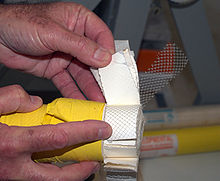User:Desalinfo/recovery
Desalination
[edit]>>>>>>>>>>>>>>>>>>>>>>>>>>>>>>>>>>>>>>>>>>>>>>>>>>>>>>>>>>>>>>>>>>>>>>>>>
High pressure pump
[edit]The HP pump supplies the pressure needed to push water through the membrane, even as the membrane rejects the passage of salt through it. Typical pressures for brackish water range from 225 to 375 psi (15.5 to 26 bar, or 1.6 to 2.6 MPa). In the case of seawater, they range from 800 to 1,180 psi (55 to 81.5 bar or 6 to 8 MPa). This requires a large amount of energy. Where energy recovery is used, all or part of the high pressure pump's work is done by the energy recovery device, reducing the system energy input.
Membrane assembly
[edit]
The membrane assembly consists of a pressure vessel with a membrane that allows feedwater to be pressed against it. The membrane must be strong enough to withstand whatever pressure is applied against it. RO membranes are made in a variety of configurations, with the two most common configurations being spiral-wound and hollow-fiber.
Only a part of the saline feed water pumped into the membrane assembly passes through the membrane with the salt removed. The remaining "concentrate" flow passes along the saline side of the membrane to flush away the concentrated salt solution. The percentage of desalinated water produced versus the saline water feed flow is known as the "recovery ratio". This varies with the salinity of the feed water and the system design parameters: typically 20% for small sea water systems, 40% for larger sea water systems and 80% for brackish water. The concentrate flow is at typically only 3 bar / 50 psi less than the feed pressure, and thus still carries much of the HP pump input energy.
The desalinated water purity is a function of the system design. Higher purity needs more equipment and more energy. Purity expressed as Total dissolved solids typically varies from 100 to 400 ppm (parts per million = milligram/litre). 500ppm is generally accepted as the upper limit for drinking water, while the U.S. Food and Drug Administration classifies mineral water as water containing at least 250ppm.
Energy Recovery
[edit]Much of the HP pump input energy can be recovered from the concentrate flow, and it is the increasing efficiency of energy recovery devices that has greatly reduced the energy needs of reverse osmosis desalination. Devices used, in order of invention, are...
- Turbine or Pelton Wheel: a water turbine driven by the concentrate flow, connected to the HP pump drive shaft to provide part of its input power. Positive displacement axial piston motors have also been used in place of turbines on smaller systems.
- Turbocharger: a water turbine driven by the concentrate flow, directly connected to a centrifugal pump which boosts the high pressure pump output pressure, reducing the pressure needed from the HP pump and thereby its energy input. Similar in construction principle to car engine turbochargers
- Pressure Exchanger: using the pressurised concentrate flow, in direct contact or via a piston, to pressurise part of the membrane feed flow to near concentrate flow pressure. A boost pump then raises this pressure by typically 3 bar / 50 psi to the membrane feed pressure. This reduces flow needed from the high pressure pump by an amount equal to the concentrate flow, typically 60%, and thereby its energy input. These are widely used on larger low-energy systems. Examples are the DWEER, the rotary pressure exchanger and the Danfoss iSave [1]
- Pressure Recovery Pump: a reciprocating piston pump having the pressurised concentrate flow applied to one side of each piston to help drive the membrane feed flow from the opposite side. These are the simplest energy recovery devices to apply, combining the HP pump and energy recovery in a single self-regulating unit. These are widely used on smaller low-energy systems. Examples are the Clark Pump[2], the Katadyn desalinators [3], and the Spectra Pearson Pump [4].
>>>>>>>>>>>>>>>>>>>>>>>>>>>>>>>>>>>>>>>>>>>>>>>>>>>>>
References
[edit]- ^ Danfoss iSave Danfoss A/S. Retrieved on 2013-06-26
- ^ The Spectra Clark Pump Spectra Watermakers Inc. Retrieved on 2013-06-26.
- ^ Katadyn desalinators Katadyn Products Inc. Retrieved on 2013-06-26
- ^ Spectra Pearson Pump Spectra Watermakers Inc. Retrieved on 2013-06-26
